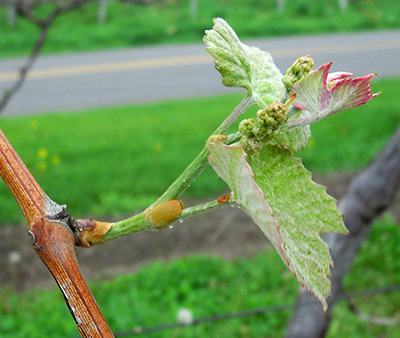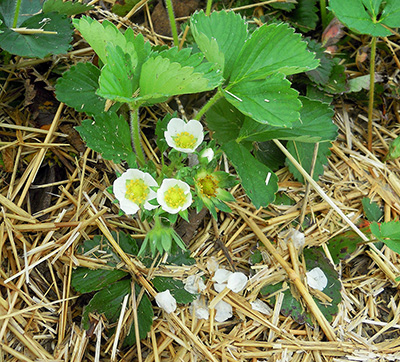Southwest Michigan fruit regional report – May 12, 2015
Apple bloom is ending, blueberry bloom has begun and overall fruit crops look good.

Weather
Last week was warm and wet. A cool front moved through the region Monday, May 4, 2015, bringing rain on Tuesday, May 5. Hot, dry conditions prevailed Wednesday and Thursday, May 6-7, with highs in the mid-80s. The warm, wet conditions caused rapid plant growth with trees blooming and leafing out rapidly over the week. Rain returned Friday, May 8, and the weekend was cooler and wet. The wet weekend was a major infection period for plant diseases. Passage of a cold front on Monday, May 11, brought more rain. Rainfall totals for the week ranged from 1.5 to 2.5 inches and soils are wet.
Low temperatures last week were in the upper 50s. Highs temperatures fell over the weekend into the 60s and cool conditions are predicted for the next several days. Drier conditions are forecasted this week with rain forecasted for Friday, May 15. The high temperatures will rise to 80 by the end of the weekend. Low temperatures are forecast near 40 Tuesday and Wednesday and then rising into the 50s. Following the warm weekend, a storm system similar to the one last Friday is expected early next week.
Southwest Michigan GDD summary from Jan. 1 to May 10, 2015 | |||
|---|---|---|---|
|
Station |
GDD 42 F |
GDD 45 F |
GDD 50 F |
|
Bainbridge/Watervliet |
458 |
357 |
225 |
|
Lawton (Lawton) |
487 |
383 |
251 |
|
Fennville (TNRC) |
378 |
289 |
175 |
|
Average for the region |
468 |
366 |
232 |
Note: We have switched to the Bainbridge Enviro-weather station due to missing data from a system update at the SWMREC Enviro-weather station.
Tree fruit
Bloom has ended in stone fruit. Last week’s warm, dry conditions were good pollinating conditions. Lots of new leaves emerged during last week’s warm conditions. Wet conditions require protection for leaves, flowers and fruit. As leaf tissue becomes available, warm and wet conditions are conducive to bacterial spot, a disease of peaches and plums. Fruit development is still spread out across the region with southern orchards and areas closer to Lake Michigan several days behind.
Plum curculio will become a risk during warmer days and nights as stone fruit emerge from the shuck. Tarnished plant bug can build up on broadleaf weeds on orchard floors and can be a threat to growing fruit.
Apricots are out of the shuck and fruit are 12 millimeters in diameter.
Peaches are in in the shuck. Oriental fruit moth adults were caught in good numbers starting at the beginning of this month. Oriental fruit moth egg hatch is underway. Growers using copper to suppress bacterial leaf spot should continue to reduce the rate as more leaf tissue is exposed. Now is the time to look for western flower thrips flying around and damaging nectarines in the shuck.
Sweet cherries are 8-10 millimeters in diameter and are susceptible to brown rot at all stages of development. Shoot growth has begun and leaves are susceptible to cherry leaf spot. Last week’s rains were heavy cherry leaf spot infections. Copper should not be used on sweet cherries after bud burst.
Tart cherries are in the shuck. The crop looks good, but we will know more as the fruit emerges. Leaves have emerged and trees have greened up. Growers need to protect against cherry leaf spot. The wet, rainy weekend was a major cherry leaf spot infection across the region. This long infection period allowed cherry leaf spot to get established early. Growers need to be sure they are protected as the season progresses to slow disease development. Tart cherries are tolerant to copper and copper applications may help reduce bacterial canker and cherry leaf spot in cherries.
Japanese plums are coming out of the shuck. European plums are still in the shuck. Plums are susceptible to bacterial leaf spot. Growers need to protect against black knot until shoot growth ceases later in the season.
Apples are in petal fall and shoot growth is 2 to 3 inches long. Early varieties such as Zestar and Ida Red are completely out of bloom. Late blooming varieties such as Rome are just past full bloom and still have some unopened flowers on the trees. With last week’s rapid bloom development and rains, growers were busy applying protective sprays. Last week’s rains with long wetting periods were severe apple scab infections. The symptoms from scab infections in early April appeared last week, and symptoms from last week’s rain should appear early next week on May 16 and 18.
The warm rains on Friday, May 8, were a fire blight infection. Many growers were aware of the high risk of fire blight and were able to apply Kasumin before the rain. Bloom was opening rapidly during the hot weather and many growers and consultants fear that fire blight will be established in many apple orchards. Cooler weather this week will suppress any fire blight blossom blight symptoms until the following week. Michigan State University Extension suggests apple growers with concerns about fire blight treat 2015 as an epidemic year and use Apogee to reduce shoot growth and fire blight spread.
Insect activity increased with the warm weather and pollination conditions for apples were excellent during early bloom. We are catching spotted tentiform leafminers in good numbers and now is the treatment window for protecting the leaves from the first generation of this pest. This week’s cooler weather should suppress insect activity. Plum curculio should not be a problem until we get warmer days and nights. Cooler conditions should also suppress codling moth, but growers and scouts should have traps out to determine biofix and time their control measures.
With cool weather this week, it will be a poor apple thinning window. All chemical thinners work poorly under cool conditions. The Cornell Carbohydrate Model for the Benton Harbor Enviro-weather station predicts low stress (low demand and high supply of carbohydrate) for the week. Delay thinning sprays to the weekend or beyond.

The Cornell Carbohydrate Model for the Southwest Michigan Horticultural Research Center, Benton Harbor, Michigan. The model estimates the carbohydrate status of apple trees as affected by current weather and tree growth stage. When the carbohydrate balance is low, the tree has a greater tendency to drop fruit. The model also shows projected carbohydrate balance status based on weather forecasts.
Pears have finished bloom. Monitoring now for pear psylla is timely to determine the need for post-bloom chemical control. Rattail bloom in pears is susceptible to fire blight and the warm conditions this weekend may need continued fire blight protection.
Small fruit
Grapes moved quickly with the warm weather. Shoots are in the 3-inch long range, and flower clusters are exposed in juice grapes. In wine grapes, bud break has occurred and there is 1-2 inches of shoot growth. Growers need to focus on early season disease control. At this time, the primary disease is phomopsis. MSU Extension advises growers to apply a protectant fungicide or biological material in vineyards affected by phomopsis during the first few inches of shoot growth to prevent disease lesions on new shoots. Phomopsis shoot lesions will slow vine growth and worsen next year’s infections.
Powdery mildew and anthracnose may also be protected against at this time, particularly in vulnerable varieties with a history of infection. There is a lot of powdery mildew inoculum in the vineyards from last fall. Powdery mildew cleistothecia produce spores above 50 degrees with any rain.
A male grape berry moth was trapped during the warm weather last week. It is too early for treatment. The first generation of grape berry moths lay their eggs during bloom and feed in the developing fruit clusters. We are still several weeks away from bloom.

Concord grape shoot with two leaves out and flower clusters exposed.
Blueberry bloom began late last week and is now widespread. Given the cool conditions, growers should focus on maximizing blueberry pollination. Shoot growth and leaf emergence are well underway.
With the rapid growth, winter injury is easy to assess even from the road while driving by fields. This winter, there was damage to flower buds. Flower buds injured by winter cold expand slowly if the flower buds inside were killed. These buds may open to reveal an empty bud or not open at all. These bushes show a lack of bloom at the shoot tips. It appears there is much less injury to leaves and shoots than last year. In many fields, older shoots that carried a crop but had few leaves last year were not removed. These canes appear dead or show poor growth with many damaged fruit buds. Vigorously pruned fields with younger, more vigorous canes do not show as much damage. It is too early to estimate the level of crop damage. There is good bloom in many fields. In 2014, there was severe winter damage across the region and despite fears of a reduced crop, Michigan harvested 94 million pounds; the fifth largest crop in history.
Wet conditions during bloom can set up good conditions for blossom and twig blight diseases in blueberries. Wet conditions will require protecting flower clusters. MSU Extension reminds growers to avoid pesticide sprays to blooming crops when bees are foraging in the field – even fungicide sprays. Avoid spraying during the mid-day; apply sprays at night, during the early morning or evening hours when bees are not active.
Strawberry bloom began last week. Open flowers are killed by temperatures below 28 degrees. There is a slight risk of a frost Thursday morning, May 14, when winds calm. Remember, temperatures near the ground are much colder than reported temperatures, which are recorded 4 feet above the ground. With these wet conditions, growers need to protect open strawberry blossoms and leaves.

Strawberry bloom is underway. Two flowers in this photo have been pollinated and lost their petals.
Bramble shoots are 2 to 4 inches long and flower clusters have emerged. Primocanes are beginning to show good growth with the rain and warmer weather. Given the wet conditions and winter injury in many fields, growers may want to apply broad spectrum fungicides to protect against leaf and cane diseases. Scout black raspberries for signs of orange rust and remove infected plants.
Upcoming meetings
Our next Monday fruit IPM meeting is May 18 at Fruit Acres Farms, 3452 Friday Rd, Coloma, MI 49038 at 5 p.m. Two Michigan pesticide applicator recertification credits will be given for these meetings.
See also
- Monitoring for the risk of frost and freezing temperatures
- Integrated pest management resources at MSU
- Minimizing pesticide exposure to bees in fruit crops
- Management of bacterial spot on peaches and nectarines
- Fungicide resistance management considerations for cherry leaf spot control
- Fungicide considerations for cherry leaf spot control at first cover
- The “Apogee effect” – examination of the mode of action of prohexadione calcium in shoot blight
- Applying multiple Apogee applications in apples
- Use of Apogee for shoot blight control in 2012
- How to use Enviro-weather’s apple scab tool
- Stay ahead of apple scab in 2011
- SDHI fungicides for apple scab management
- Codling moths: Thinking about Enviro-weather model and hot and cold temperatures
- First generation codling moth management
- Use Precision Cropload Management tools to target apple crop load
- Protect young grape clusters from all major grape diseases
- Protect against blossom blights in blueberries
- Keep bee safety in mind during bloom
- A detailed description of the Cornell model and thinning strategies by MSU Extension Fruit Educator Phil Schwallier can be found at the MSU Apple website posted as “PGR’s and Thinning Strategies.”



 Print
Print Email
Email



